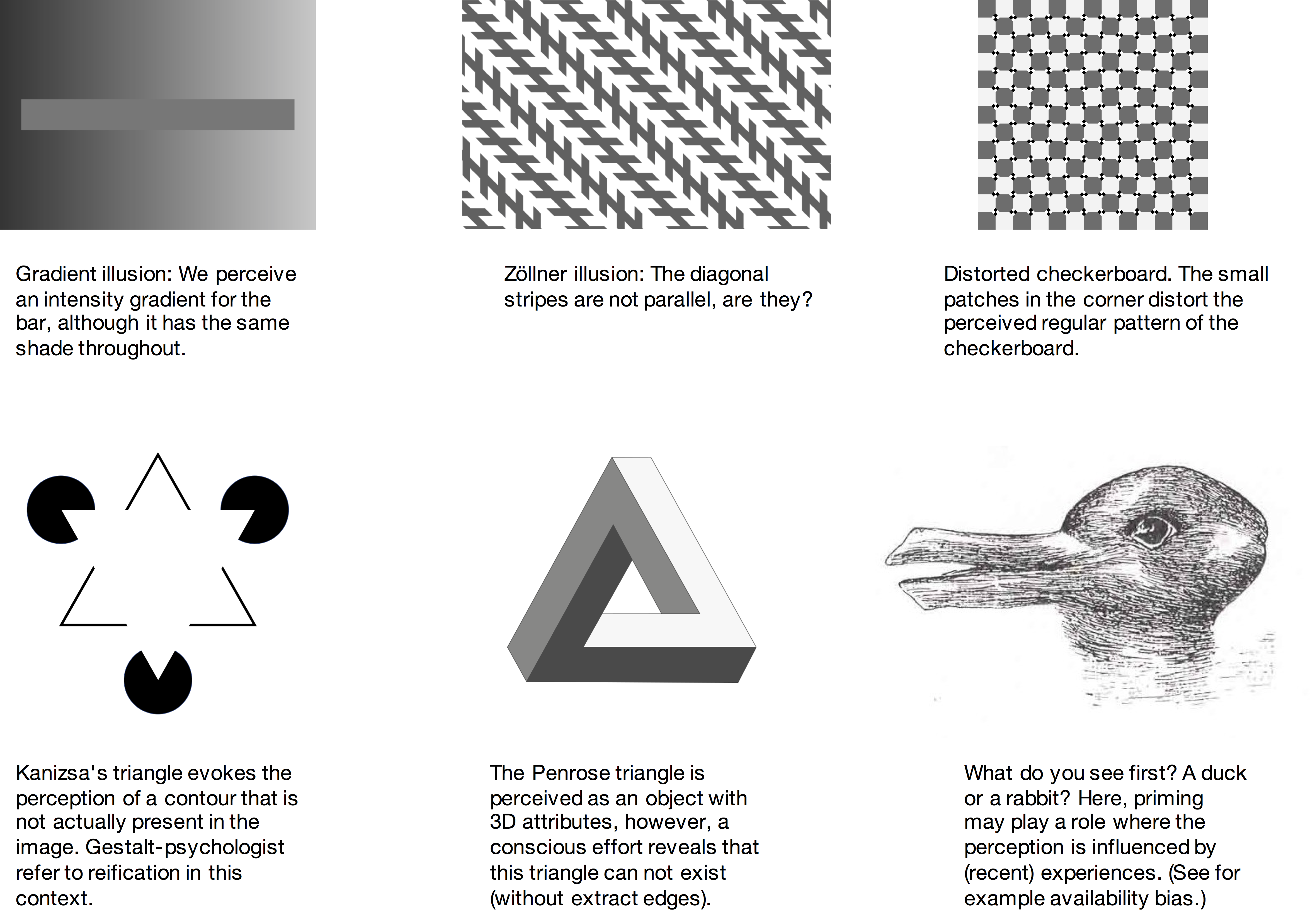Blog
Cognitive biases
You certainly know drawings like those shown below. They are optical illusions, and are designed to deceive our visual perception. Multiple forms of illusions exist. Exact categorization on an objective level is difficult, however, because the illusions result from a combination of physical properties of the stimuli, physiologic characteristics of visual perception, and, most importantly, traits of the cognitive system as a whole.
Some of the optical illusions emerge because the lower-level perceptual system hints on an attribute that does not actually exist or are inconsistent with other observations for that object. This confuses the higher-level cognition processes that are fed with such unconscious pre-assessments of the visual. The surprise or discomfort we experience when we become aware of such illusions is the reason why optical illusions are so intriguing to all of us. Our cognition is misguided, even if we are prepared, there is little we can do to avoid it, besides just closing the eyes, of course.
The study of optical illusions is scientifically interesting because it provides hints on how visual cues are organized while or before the observation enters cognition. Gestalt psychology, based on the study of optical illusions and (more generally) structured visual patterns as shown in the figure below, suggested some principles of perception.*
I guess this was nothing new for you, but the following may be. Have you already considered that more of such hardwiring is at work beyond the processing of sensory stimuli? That also the higher-level perception of the world around us is equally prone to the suggestive power of the lower-level circuitry? And that other areas of cognition like reasoning and decision making are affected as well?
By the time we observe an object consciously, many of its features have been assessed already – whether it moves, whether it is sharp, whether it is edible, whether it is angry at us and may well bite us, and so on**. All our subsequent mental actions are to a large degree based on these intuitive assessments. And it appears that there is little hope to evade these pre-assessments (except for experimenting with narcotics, maybe). Several proponents, such as Daniel Kahneman, argue that we underestimate how strongly our decisions are influenced by this subconscious pattern matching.
Like optical illusions, cognitive biases result as side effects of a nervous system that has been optimized for the survival in an environment that our forebears used to live in. An efficient reduction of the steady stream of (sensory) information or the ability to infer missing information from observations were certainly helpful for survival. Where did this cracking noise come from? Is this a tiger approaching behind the tree? Likewise, being able to make decisions quickly represented a selective advantage as well. So our perceptual and cognitive system developed shortcuts to deal with the abundance or lack of information, depending on the context. And here we are: Thinking about moral standards, common interests and objective reasons for attractiveness would be a tough piece of conscious work – but my guts can tell me immediately whether I like a person or not.
Some time ago, I stumbled upon www.yourbias.is where some of the top cognitive biases are memorably prepared. Spend some time to go through these biases – you will immediately recall daily situations where one or the other bias might have played a role. And the task shall not be to guess on the biases that others may suffer from. Think of yourself. In political discussions, when gossiping about a working colleague, deciding on a purchase, or when planning your next career step – what do you think are your subconscious drifts?
Cognitive biases play an underestimated role in our understanding of and reasoning about the world we live in. And not least, this affects the way we work and communicate in a scientific context. Learning about our biases can be tough at times, but I am convinced that it is for the good.
* You may be already familiar with the law of proximity or the law of similarity (close-by objects or objects with similar perceptual attributes tend to form a perceptual group). Note that a correspondence on the level of neuronal circuitry has not been found conclusively yet for these Gestalt principles, but there have been several recent advancements in this field.
** Actually, it is rather the other way around: The nervous system does not perform all possible tests in a strict procedure. Rather, it accumulates observational cues about the object’s properties in an integrative manner, and once enough evidence has piled up, the cue is forwarded to the higher level processing units of the brain. But my point remains valid: the “fast thinking” brain provides various hints on how to approach an object, even before we are able to consciously identify that object.
Further reading
The following sources inspired me to write my little digest of this topic.
- Buster Benson’s blog post gives a fantastic overview on the different types of cognitive biases.
- www.yourlogicalfallacy.is – the small brother of your cognitive biases, but just as fun and painful to learn.
- Daniel Kahneman. Thinking, fast and slow. Macmillan, 2011. Already a classic.
- A TEDx talk that encourages teaching ourselves more about cognitive biases.

